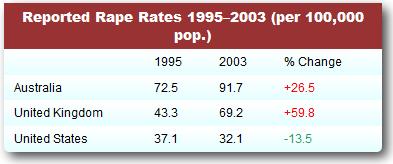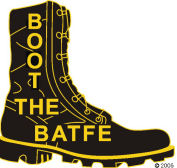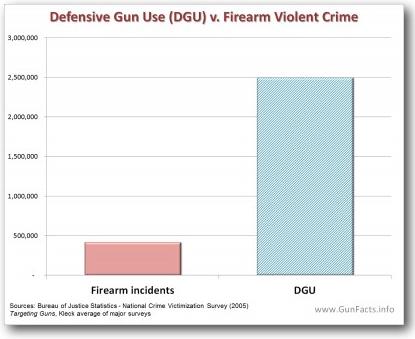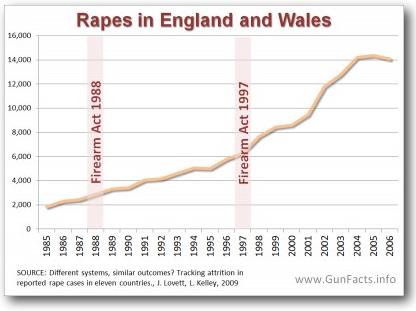

![]()
Guns and Crime Prevention
Myth: Private ownership of guns is not effective in preventing crime
By Guy Smith. GunFacts.info
Fact: Every year, people in the United States use guns to defend themselves against criminals an estimated 2,500,000 times – more than 6,500 people a day, or once every 13 seconds. [1] Of these instances, 15.7% of the people using firearms defensively stated that they “almost certainly” saved their lives by doing so.
Fact: Even the governments estimate, which has a major methodology problem, [2] estimates people defend themselves 235,700 times each year with guns. [3]
Fact: The number of times per year an American uses a firearm to deter a home invasion alone is 498,000. [4]
Fact: In 83.5% (2,087,500) of these successful gun defenses, the attacker either threatened or used force first, proving that guns are very well suited for self-defense.
Fact: The rate of defensive gun use (DGU) is six times that of criminal gun use. [5]
Fact: Of the 2,500,000 times citizens use guns to defend themselves, 92% merely brandish their gun or fire a warning shot to scare off their attackers.
Fact: Less than 8% of the time does a citizen wound his or her attacker, and in less than one in a thousand instances is the attacker killed. [6]
Fact: In one local review of firearm homicide, more than 12% were civilian legal defensive homicides. [7]
Fact: For every accidental death (802), suicide (16,869) or homicide (11,348) [8] with a firearm (29,019), 13 lives (390,000) [9] are preserved through defensive use.
Fact: When using guns in self-defense, 91.1% of the time, not a single shot is fired. [10]
Fact: After the implementation of Canada’s 1977 gun controls prohibiting handgun possession for protection, the “breaking and entering” crime rate rose 25%, surpassing the American rate. [11]
Myth: Only police should have guns
Fact: “Most criminals are more worried about meeting an armed victim than they are about running into the police.” [12]
Fact: For kids in schools, police put an end to such attacks only 27% of the time. [13]
Fact: 11% of police shootings kill an innocent person – about 2% of shootings by citizens kill an innocent person. [14]
Fact: Police have trouble keeping their own guns. Hundreds of firearms are missing from the FBI and 449 of them have been involved in crimes. [15]
Fact: People who saw the helplessness of the L.A. Police Department during the 1992 King Riots or the looting and violence in New Orleans after hurricane Katrina know that citizens need guns to defend themselves.
Fact: “In actual shootings, citizens do far better than law enforcement on hit potential. They hit their targets and they don’t hit other people. I wish I could say the same for cops. We train more, they do better.” [16]
Myth: You are more likely to be injured or killed using a gun for self-defense
Fact: You are far more likely to survive violent assault if you defend yourself with a gun. [17]
Myth: Guns are not effective in preventing crime against women
Fact: Of the 2,500,000 annual self-defense cases using guns, more than 7.7% (192,500) are by women defending themselves against sexual abuse.
Fact: When a woman was armed with a gun or knife, only 3% of rape attacks were completed, compared to 32% when the woman was unarmed. [18]
 Fact:The probability of serious injury from an attack is 2.5 times greater for women offering no resistance than for women resisting with guns. Men also benefit from using guns, but the benefits are smaller: Men are 1.4 times more likely to receive a serious injury. [19]
Fact:The probability of serious injury from an attack is 2.5 times greater for women offering no resistance than for women resisting with guns. Men also benefit from using guns, but the benefits are smaller: Men are 1.4 times more likely to receive a serious injury. [19]
Fact: 28.5% of women have one or more guns in the house. [20]
Fact: 41.7% of women either own or have convenient access to guns. [21]
Fact: In 1966, the city of Orlando responded to a wave of sexual assaults by offering firearms training classes to women. Rapes dropped by nearly 90% the following year.
Fact: Firearm availability appears to be particularly useful in avoiding rape. The United Kingdom virtually banned handgun ownership. During the same period handgun ownership in the United States steadily rose. Yet the rate of rape decreased in the United States and skyrocketed in the other countries, as shown in the table.
Fact: More Americans believe having a gun in the home makes them safer. This belief grows every year the survey is taken. [22]
Fact: Arthur Kellerman, a researcher whose work is often cited by gun control groups, said “If you’ve got to resist, your chances of being hurt are less the more lethal your weapon. If that were my wife, would I want her to have a .38 Special in her hand? Yeah.” [23]
Notes:
1. Journal of Criminal Law and Criminology, Kleck and Gertz, Fall 1995 Back
2. This ongoing victimization survey involved people from the government personally interviewing victims in person. Some criminologists believe this induces self-reporting biases (e.g., people don’t like to tell the government they own a gun). Thus this low number from the National Crime Victimization Survey is considered to be an outlier and not reliable. Back
3. Firearm Violence, 1993-2011, Bureau of Justice Statistics, May 2013 Back
4. Estimating intruder-related firearm retrievals in U.S. households, 1994. Robin M. Ikeda, Violence and Victims, Winter 1997 Back
5. Crime statistics: Bureau of Justice Statistics - National Crime Victimization Survey (2005). DGU statistics: Targeting Guns, Kleck (average of 15 major surveys where DGUs were reported) Back
6. Targeting Guns, Gary Kleck, Aldine de Gruyter, 1997, from the National Self-Defense Survey Back
7. Death by Gun: One Year Later, Time Magazine, May 14, 1990 Back
8. Unintentional Firearm Deaths, 2001, U.S. Centers for Disease Control and Prevention, National Center for Injury Prevention and Control Back
9. Targeting Guns, Gary Kleck, Aldine de Gruyter, 1997 Back
10. National Crime Victimization Survey, 2000 Back
11. Residential Burglary: A Comparison of the United States, Canada and England and Wales, Pat Mayhew, National Institute of Justice., Wash., D.C., 1987 Back
12. Armed and Considered Dangerous: A Survey of Felons and Their Firearms, Wright and Rossi, 1986 Back
13. Implications for the Prevention of School Attacks, United States Secret Service and United States Department of Education, 2002 Back
14. Shall issue: the new wave of concealed handgun permit laws, Clayton Cramer, David Kopel, Independence Institute Issue Paper. October 17, 1994 Back
15. ABC News, July 17, 2001 Back
16. Sheriff Greg White, Cole County, Missouri, Guns to be allowed on campus?, KRCG News, July 31, 2009 Back
17. The Value of Civilian Handgun Possession as a Deterrent to Crime or a Defense Against Crime, Don B. Kates, 1991 American Journal of Criminal Law Back
18. Law Enforcement Assistance Administration, Rape Victimization in 26 American Cities, U.S. Department of Justice, 1979 Back
19. National Crime Victimization Survey, Department of Justice Back
20. 2001 National Gun Policy Survey of the National Opinion Research Center: Research Findings, Smith, T, National Opinion Research Center, University of Chicago, December 2001. Back
21. 2001 National Gun Policy Survey of the National Opinion Research Center: Research Findings, Smith, T, National Opinion Research Center, University of Chicago, December 2001. Back
22. Americans by Slight Margin Say Gun in the Home Makes It Safer, Gallup Poll, October 20, 2006 Back
23. Gun Crazy, S.F. Examiner, April 3, 1994 Back
![]()



























